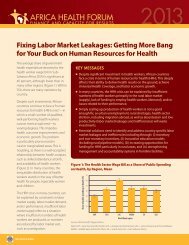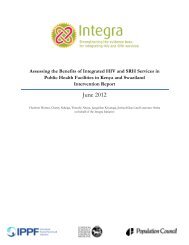ujh78
ujh78
ujh78
You also want an ePaper? Increase the reach of your titles
YUMPU automatically turns print PDFs into web optimized ePapers that Google loves.
education by two percentage points. In every country except Sao Tomé and Príncipe, the percentage of<br />
children under 18 years old without education was higher in rural areas than in urban areas<br />
In 18 countries the percentage without a primary or secondary education was at least one<br />
percentage point higher for children living with a male rather than a female head of household. We did<br />
not find the inverse situation in any sub-Saharan Africa country. In some countries the age of the<br />
household head was not associated with children’s lack of education. In other countries the percentage<br />
without education was higher among children living with a household head 50 years or older. In every<br />
country the percentage of children without education has decreased during the last 13 years.<br />
Children not currently enrolled in school. By sex, the greatest differences in the percentage of<br />
children up to age 17 years who were not enrolled in school occurred in Benin, Chad, Cote d’Ivoire,<br />
Guinea, and Niger, where the percentage was at least 10 points higher for females than for males. We<br />
found no rural-urban disparities in Rwanda, Swaziland, or Uganda. In the rest of the countries, however,<br />
the percentage of children who were not enrolled in school was at least one percentage point higher in<br />
rural areas than in urban areas. The sex of the household head played an important role in the percentage<br />
of children not enrolled in school. In five countries—Benin, Burkina Faso, Cameroon, Nigeria, and<br />
Senegal—this percentage was at least five percentage points higher for children in a male-headed<br />
household. By comparison, only in Chad was this percentage at least five percentage points higher for<br />
children living with a female head of household. In nine countries the percentage of children not enrolled<br />
in school was at least five percentage points higher for children living with a household head 50 years or<br />
older than those living with a household head less than age 50. In every country in sub-Saharan Africa the<br />
percentage of children age 7-17 not enrolled in school decreased by at least one percentage point during<br />
the last 13 years. Ethiopia and Zambia experienced the greatest decrease—at least 15.0 percentage points.<br />
School dropouts. Overall, the percentage of children age 7-12 who had dropped out of school<br />
was very low, reaching no more than 3.6% in any country except Burkina Faso (7%), but at age 13-17<br />
dropout rates rise, ranging from less than 4% in Kenya to nearly 35% in Burkina Faso. Dropout rates were<br />
similar for the two sexes. However, we found geographic disparities in the percentage of children who<br />
dropped out of school in two countries. In Burkina Faso and Madagascar dropout rates were at least six<br />
percentage points higher in rural areas than in urban areas. There was no association between the sex of<br />
the household head and the percentage of children who dropped out of school. In Burkina Faso the<br />
percentage of dropout rates was higher for children living in female-headed households than for children<br />
in male-headed households (24% versus 17%). Reductions of at least six percentage points in the<br />
proportion of children age 7-17 who dropped out school occurred in Benin, Ghana, Kenya, and Zambia.<br />
In summary, this report provides information on the current status and trends on five types of<br />
deprivation: food, water and sanitation, health, shelter, and education. Several important findings will<br />
help in the design and evaluation of programs and help program planners and policymakers to achieve<br />
national objectives. First, in many sub-Saharan African countries, greater effort is needed to reduce sex<br />
and geographic disparities related to children’s deprivation. In some cases programs also should address<br />
the role that the age and sex of the household head plays in the percentage of children experiencing these<br />
deprivations. Despite overall reductions in the exposure to some of these types of deprivation, some<br />
countries are still struggling to make and sustain improvements.<br />
140








